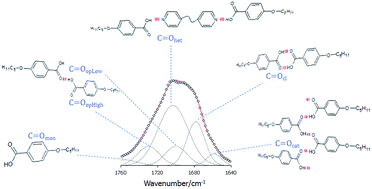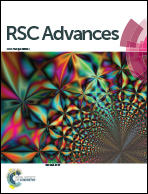An FT-IR spectroscopic study of the role of hydrogen bonding in the formation of liquid crystallinity for mixtures containing bipyridines and 4-pentoxybenzoic acid†
Abstract
We have studied the relationships between liquid crystallinity and hydrogen bonding in mixtures containing 4-pentoxybenzoic acid, 5OBA, and five bipyridines, XBiPy, with spacers having different flexibilities, namely: 4,4′-bipyridine (BiPy), 1,2-bis(4-pyridyl)ethane (EthaBiPy), trans-1,2-bis(4-pyridyl)ethylene (EthylBiPy), 4,4′-trimethylene-dipyridine (PropBiPy), and 4,4′-tetramethylene-dipyridine (ButBiPy). The XBiPy/5OBA mixtures exhibit liquid crystal behaviour for a range of acid concentrations, and predominantly smectic behaviour. The 1 : 2 mixtures have been studied using temperature-dependent Fourier transform infrared spectroscopy, FT-IR, with particular focus on the Fermi bands associated with the hydroxyl groups and on the carbonyl stretching regions. The latter has been interpreted in terms of contributions arising from a number of species, namely the heterocomplex, and free, dimeric and oligomeric acid species. This analysis reveals that the heterocomplexes formed by hydrogen bonding between the unlike species tend to be the dominant species but at all temperatures coexist in equilibria with acid monomers, dimers and oligomers. The hydrogen bond strength in the heterocomplexes is predicted by molecular modelling to be stronger than that in the acid dimers. The smectic behaviour of these mixtures is accounted for in terms of the stabilisation of the layered structures arising from hydrogen bonded catemer strands. The liquid crystal behaviour of these and similar hydrogen bonded liquid crystals, HBLCs, cannot be explained solely by the formation of the heterocomplex between the unlike species, but instead a more realistic view must take into account the presence and concentrations of various different supramolecular species and the interactions between them.


 Please wait while we load your content...
Please wait while we load your content...